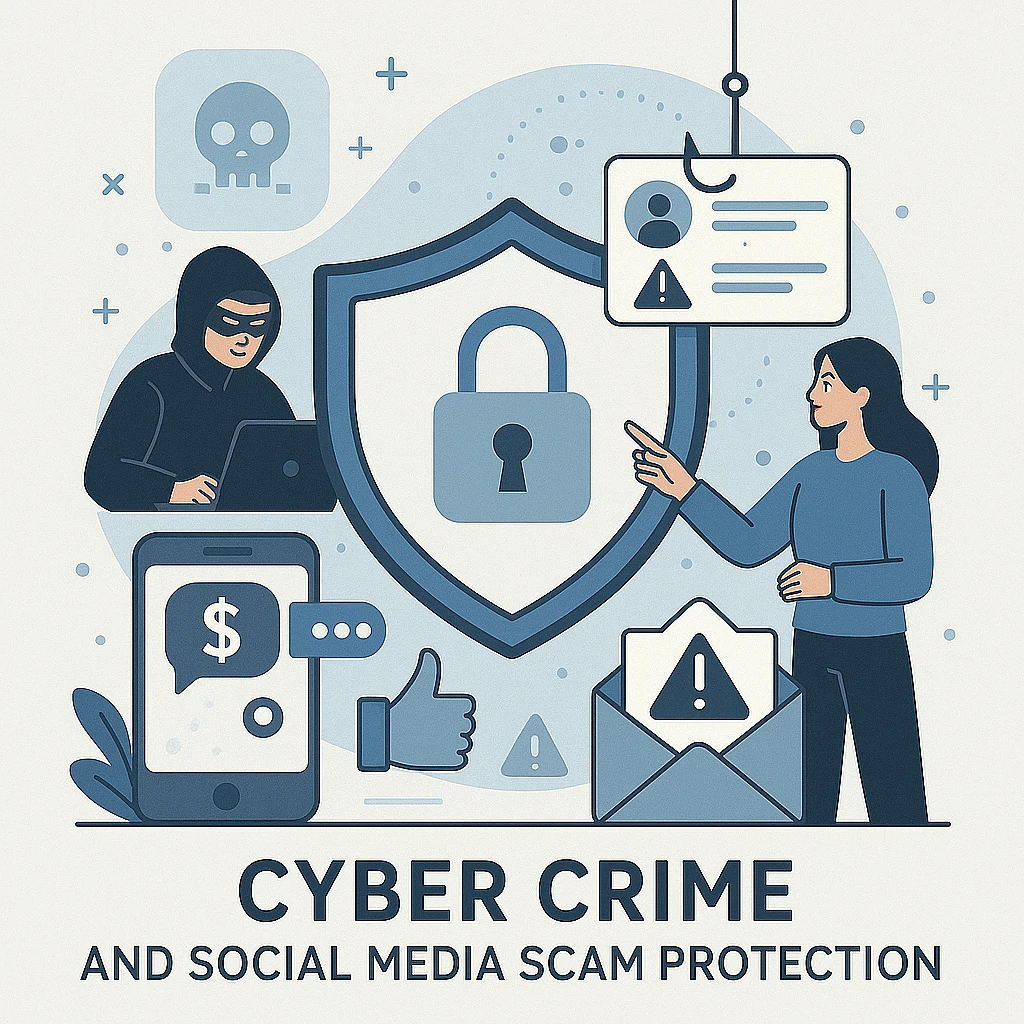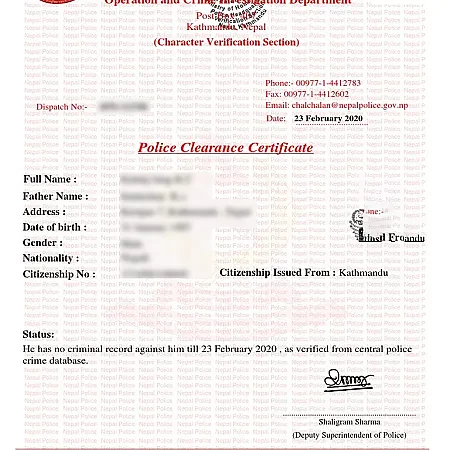Legal and technical measures to be safe from social media scam and cyber phishing
Introduction
In our increasingly interconnected global landscape, social media platforms have evolved far beyond their original purpose as simple communication tools. Unfortunately, they've also become fertile hunting grounds for cybercriminals employing sophisticated tactics.
These digital predators deploy an expanding arsenal of scams and phishing operations designed to manipulate unsuspecting users, extract sensitive information, and hijack online identities. The alarming proliferation of these cyber threats necessitates more robust protective measures both legal frameworks and technical safeguards especially in emerging economies such as Nepal where digital literacy and cybersecurity infrastructure may be still developing.
As social media penetration reaches unprecedented levels worldwide, the corresponding security challenges have grown exponentially, leaving vulnerable populations particularly exposed to these evolving digital dangers. The situation calls for comprehensive strategies that combine technological solutions, regulatory oversight, and educational initiatives to create safer online environments for all users.
Technical Countermeasures Against Social Media Criminal Activity
The battle against social media-based criminal operations has prompted the development of sophisticated technical defenses. Organizations and platforms are deploying an integrated array of technological solutions to identify, prevent, and mitigate fraudulent activities:
Core Security Infrastructure
Advanced security architectures now combine next-generation firewalls with comprehensive antivirus protection to create robust defensive perimeters. These systems work in tandem with continuous threat monitoring platforms that scan for suspicious activities around the clock, providing real-time alerts when potential threats emerge.
Authentication Enhancements
Multi-factor authentication has become an essential security layer, requiring users to verify their identities through multiple methods beyond passwords. This approach significantly reduces the risk of unauthorized access even when credentials are compromised.
AI-Powered Detection Systems
Perhaps the most transformative development has been the implementation of artificial intelligence and machine learning algorithms specifically designed to:
- Recognize abnormal behavioral patterns that may indicate account compromise
- Identify sophisticated phishing attempts that evade traditional detection methods
- Flag suspicious network traffic and unusual account activities
- Detect and block fake accounts and bot networks before they can operate at scale
These intelligent systems can analyze vast datasets to establish behavioral baselines and identify deviations that human analysts might miss. By continuously learning from new threat patterns, AI tools have shifted security postures from reactive to proactive, often neutralizing potential attacks before they fully materialize.
The integration of these technical countermeasures provides a multi-layered defense strategy that significantly strengthens the security ecosystem within social media platforms, protecting both individual users and the broader digital community.
Government Interventions to Combat Social Media Scams
Across the globe, governments have recognized the critical need to address the proliferation of social media scams through coordinated institutional responses. These efforts represent a multi-faceted approach combining regulatory frameworks, enforcement mechanisms, and strategic partnerships:
Specialized Enforcement Units
Governments, including Nepal's, have established dedicated digital surveillance divisions and specialized cybercrime task forces. These units employ trained investigators with technical expertise to monitor online platforms, gather digital evidence, and build cases against perpetrators operating in social media environments.
Legislative Frameworks
Comprehensive cybercrime legislation has been enacted to specifically address social media-based criminal activities. These laws typically define digital offenses, establish jurisdictional authority, and prescribe penalties proportionate to the harm caused. In many jurisdictions, these legal frameworks have been updated to address emerging threats and evolving criminal methodologies.
Public-Private Collaboration
Strategic partnerships between government agencies and social media companies have proven essential in addressing scams effectively. These collaborative arrangements facilitate:
- Expedited information sharing about emerging threats
- Streamlined processes for suspending fraudulent accounts
- Coordinated takedowns of scam networks operating across multiple platforms
- Joint development of technical standards and best practices
National Response Strategies
Government agencies have developed comprehensive digital response protocols specifically tailored to address social media scams. These strategies typically include:
- Standardized procedures for citizens to report suspected scams
- Centralized analysis of scam patterns to identify organized criminal networks
- Coordinated cross-border enforcement actions when scams operate internationally
- Public awareness campaigns to educate citizens about prevalent scam techniques
These governmental measures represent an essential component of the broader societal response to social media-based fraud, complementing the technical countermeasures implemented by platforms and the vigilance of individual users.
The Formal Responsibility of Nepal's Cyber Bureau
The Cyber Bureau of Nepal Police serves as the nation's primary specialized unit dedicated to combating digital crimes. This department has been formally vested with specific responsibilities and powers to address the growing challenge of cyber offenses, including those perpetrated through social media platforms.
Core Investigative Functions
The Bureau holds explicit authority to investigate the full spectrum of cyber-related violations. This includes conducting thorough digital forensic examinations, preserving electronic evidence according to legal standards, and developing comprehensive case files to support successful prosecutions. Their work encompasses meticulous evidence collection methodologies designed specifically for digital environments, where traditional investigative approaches may prove insufficient.
Technical Capabilities
To fulfill its mandate, the Bureau has developed specialized forensic analysis capabilities that allow investigators to extract, analyze, and authenticate digital evidence from various devices and online platforms. These technical resources enable the reconstruction of digital crime scenes and the establishment of evidential links between perpetrators and their online activities.
Prosecution Support
Beyond investigation, the Bureau provides critical support to prosecutors handling cybercrime cases by:
- Preparing expert testimony regarding technical aspects of cases
- Translating complex digital evidence into formats accessible to the courts
- Advising on appropriate charges based on technical findings
- Documenting digital chain of custody to ensure evidence admissibility
International Collaboration
Recognizing the borderless nature of cybercrime, the Bureau has established working relationships with global technology companies and international law enforcement agencies. These partnerships facilitate:
- Cross-border intelligence sharing on emerging threats
- Coordinated actions against international cybercriminal networks
- Access to technical assistance for complex investigations
- Expedited processes for obtaining user data from major platforms when legally authorized
Through these formalized responsibilities and capabilities, the Cyber Bureau plays a crucial role in Nepal's broader strategy to address and other digital crimes, providing specialized expertise that bridges technological understanding with legal enforcement.
Technical and Pragmatic Measures for Personal Protection
To safeguard themselves against the growing sophistication of social media scams, individuals should implement a comprehensive set of protective practices that combine technical safeguards with vigilant online behavior:
Essential Security Practices
Users must establish fundamental security habits including:
- Maintaining current software across all devices by promptly installing updates that patch security vulnerabilities
- Creating robust, unique passwords for each online account, preferably using password management tools
- Enabling multi-factor authentication whenever available to provide an additional security layer
- Scrutinizing links before clicking, particularly those received through messages, comments, or unfamiliar sources
- Remaining vigilant for communication anomalies such as unusual requests, urgent demands, or subtle language inconsistencies from known contacts
Privacy Configuration
Social media platforms offer various privacy controls that users should optimize by:
- Reviewing and restricting visibility settings for personal information and posts
- Limiting the audience for historical content that may contain sensitive information
- Controlling third-party application access to account data
- Managing location sharing settings to prevent unintended disclosure of physical whereabouts
- Regularly auditing connected applications and revoking unnecessary permissions
Connection Security
Users should prioritize secure network practices by:
- Using encrypted connections (HTTPS) when accessing social media platforms
- Avoiding public Wi-Fi for sensitive transactions or accessing personal accounts
- Considering virtual private networks (VPNs) for additional connection security
- Being cautious about using public or shared devices to access personal accounts
Ongoing Education
Public awareness initiatives have proven effective in helping users recognize and respond to emerging threats through:
- Community-based digital literacy programs
- Organizational training on social engineering tactics
- Government-sponsored informational campaigns
- Platform-provided security notifications and guidance
By integrating these technical protections with heightened awareness and cautious online behavior, individuals can significantly reduce their vulnerability to social media scams while maintaining productive digital engagement.
How to Verify a Potential Scam
When encountering suspicious communications on social media, implementing a systematic verification process can help identify fraudulent attempts before they cause harm:
Immediate Red Flags Assessment
Examine the communication for common scam indicators:
- Grammatical errors, unusual phrasing, or inconsistent writing style
- Mismatched sender details when comparing display names with actual account handles or email addresses
- Suspicious domain names that slightly mimic legitimate organizations (e.g., "faceb00k.com" instead of "facebook.com")
- Urgency tactics that pressure you to act quickly without proper consideration
- Requests for sensitive information that legitimate organizations typically wouldn't ask for through social media
Technical Verification Steps
Take these precautionary measures before engaging with suspicious content:
- Hover over links without clicking to preview the actual destination URL in your browser's status bar
- Examine email headers for inconsistencies in routing information
- Check the sender's account creation date and activity history on the platform
- Use reverse image search on profile pictures to identify stolen photos
- Verify whether the communication follows typical patterns of legitimate organizations
Independent Confirmation
Always seek verification through official channels:
- Contact organizations directly using phone numbers or email addresses from their official websites, not those provided in the suspicious message
- Visit official websites by typing the address directly into your browser rather than following provided links
- Check official social media accounts for announcements related to the communication in question
- Use official mobile applications rather than following links in messages
- Consult official fraud awareness resources provided by the organization allegedly contacting you
Default to Caution
When uncertainty remains:
- Take no action until proper verification is complete
- Do not provide personal information, credentials, or financial details
- Refrain from downloading attachments or installing suggested applications
- Consider reporting the suspicious communication to the platform and relevant authorities
- Consult with trusted tech-savvy contacts if you're unsure about the legitimacy of a message
Following these verification practices creates a protective buffer against social engineering attempts, giving you time to properly assess communications before potentially compromising your security or privacy.
Why Nepal Lacks a Comprehensive Scam Reporting System
Nepal's absence of a centralized mechanism for reporting social media scams can be attributed to several interconnected structural challenges:
Resource Constraints
Financial limitations have significantly hindered the development of specialized cybersecurity infrastructure:
- Insufficient budget allocations for digital security initiatives amid competing national priorities
- Limited resources for acquiring and maintaining advanced detection and tracking technologies
- Inadequate funding for training specialized personnel in cybercrime investigation techniques
- Financial constraints restricting public awareness campaigns about reporting procedures
Legal Framework Gaps
The regulatory environment has not kept pace with rapidly evolving digital threats:
- Outdated legislative provisions that don't fully address modern social media fraud mechanisms
- Ambiguities in jurisdictional authority when handling cross-platform or international scams
- Procedural complexities that impede swift response to time-sensitive online threats
- Insufficient legal provisions for data sharing between agencies and platforms
Coordination Challenges
Institutional fragmentation has created obstacles to unified response capabilities:
- Limited coordination protocols between relevant government agencies
- Insufficient mechanisms for information sharing across law enforcement entities
- Unclear delineation of responsibilities between various regulatory bodies
- Absence of standardized procedures for case referrals between departments
Digital Literacy Barriers
Widespread knowledge gaps, particularly pronounced in rural communities, complicate reporting efforts:
- Low awareness about identifying sophisticated social media scams
- Limited understanding of available reporting channels among the general population
- Technological barriers preventing easy access to reporting mechanisms
- Language and accessibility challenges in existing reporting options
Infrastructure Deficiencies
Fundamental technical limitations undermine reporting capabilities:
- Inadequate technological infrastructure to support comprehensive digital reporting
- Insufficient data management systems for tracking and analyzing scam patterns
- Limited connectivity in rural regions restricting access to centralized reporting
- Challenges in maintaining secure communication channels for sensitive case information
These systemic challenges highlight the urgent need for comprehensive infrastructure modernization, capacity building, and regulatory updates to establish an effective national scam reporting framework in Nepal.
Legislative Measures Required for Enhanced Cybersecurity Governance in Nepal
To effectively combat the rising tide of social media-based cybercrimes, Nepal's government should implement a comprehensive legislative agenda focused on modernizing its digital regulatory framework:
Electronic Transactions Act Reform
The existing Electronic Transactions Act requires substantial revision to address contemporary challenges:
- Expanding its scope to specifically encompass emerging social media fraud typologies
- Updating definitions to capture evolving digital crime methodologies
- Incorporating provisions for cross-platform evidence collection and preservation
- Establishing clear jurisdictional parameters for prosecuting offenses committed through international platforms
Enhanced Penalty Framework
A more robust deterrence model should be implemented through:
- Graduated penalty structures proportionate to the scale and impact of digital offenses
- Specific provisions addressing repeat offenders in the digital space
- Clearer restitution mechanisms for victims of social media fraud
- Provisions for civil remedies alongside criminal penalties
Social Media Regulatory Framework
A dedicated legal structure governing social media operations would strengthen oversight by:
- Establishing clear obligations for platforms operating within Nepal








-thumb.webp)
-thumb.webp)
